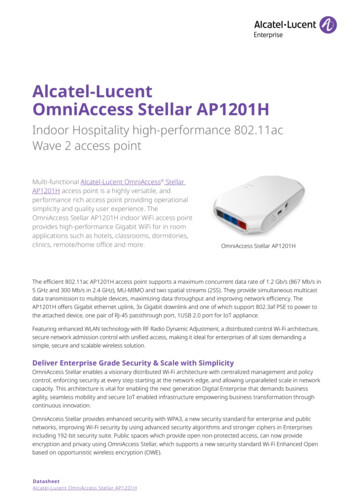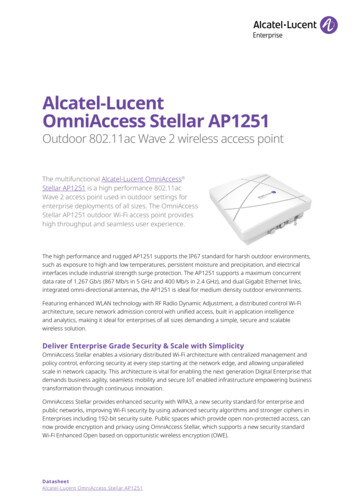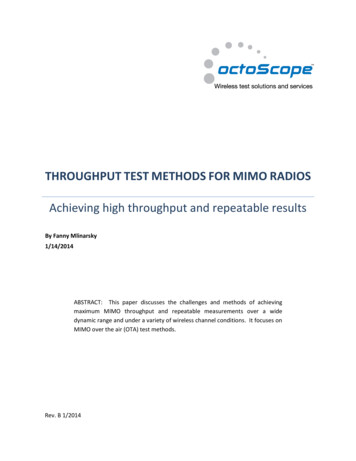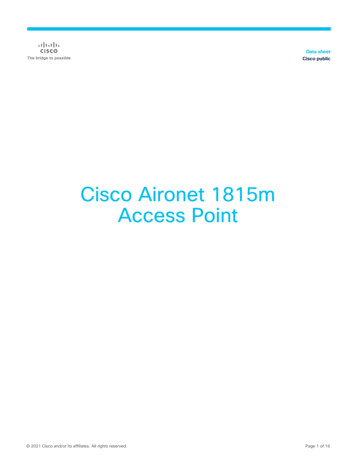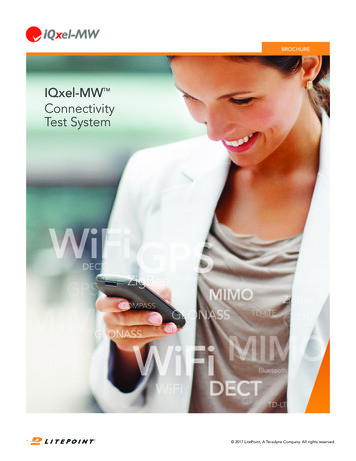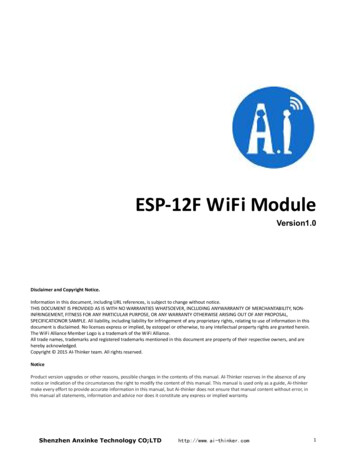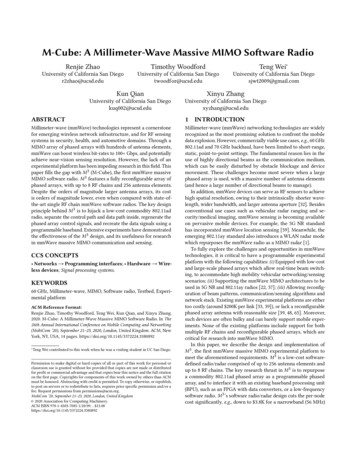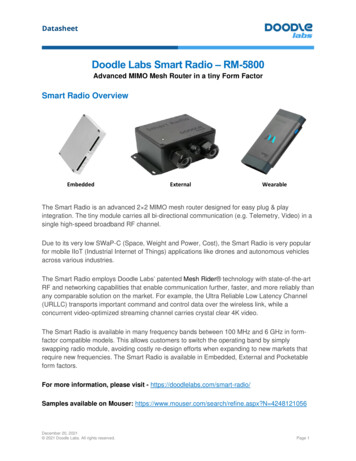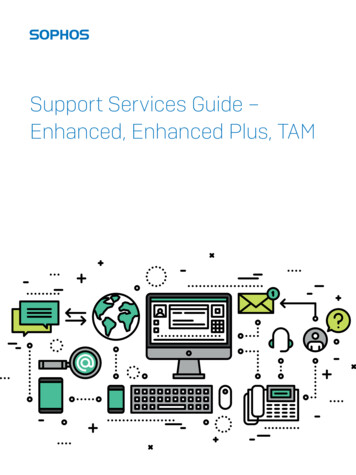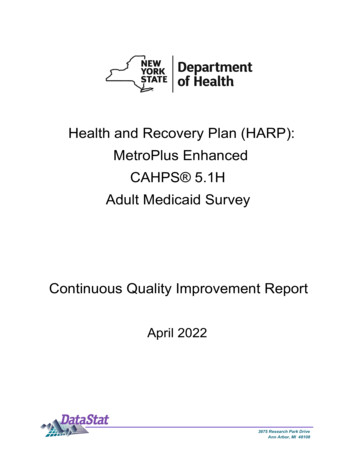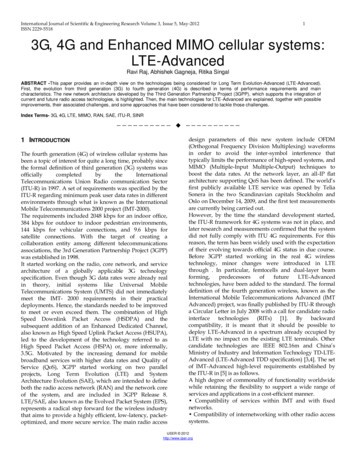
Transcription
International Journal of Scientific & Engineering Research Volume 3, Issue 5, May-2012ISSN 2229-551813G, 4G and Enhanced MIMO cellular systems:LTE-AdvancedRavi Raj, Abhishek Gagneja, Ritika SingalABSTRACT -This paper provides an in-depth view on the technologies being considered for Long Term Evolution-Advanced (LTE-Advanced).First, the evolution from third generation (3G) to fourth generation (4G) is described in terms of performance requirements and maincharacteristics. The new network architecture developed by the Third Generation Partnership Project (3GPP), which supports th e integration ofcurrent and future radio access technologies, is highlighted. Then, the main technologies for LTE-Advanced are explained, together with possibleimprovements, their associated challenges, and some approaches that have been considered to tackle those challenges.Index Terms- 3G, 4G, LTE, MIMO, RAN, SAE, ITU-R, SINR—————————— ——————————1 INTRODUCTIONThe fourth generation (4G) of wireless cellular systems hasbeen a topic of interest for quite a long time, probably sincethe formal definition of third generation (3G) systems ications Union Radio communication Sector(ITU-R) in 1997. A set of requirements was specified by theITU-R regarding minimum peak user data rates in differentenvironments through what is known as the InternationalMobile Telecommunications 2000 project (IMT-2000).The requirements included 2048 kbps for an indoor office,384 kbps for outdoor to indoor pedestrian environments,144 kbps for vehicular connections, and 9.6 kbps forsatellite connections. With the target of creating acollaboration entity among different telecommunicationsassociations, the 3rd Generation Partnership Project (3GPP)was established in 1998.It started working on the radio, core network, and servicearchitecture of a globally applicable 3G technologyspecification. Even though 3G data rates were already realin theory, initial systems like Universal MobileTelecommunications System (UMTS) did not immediatelymeet the IMT- 2000 requirements in their practicaldeployments. Hence, the standards needed to be improvedto meet or even exceed them. The combination of HighSpeed Downlink Packet Access (HSDPA) and thesubsequent addition of an Enhanced Dedicated Channel,also known as High Speed Uplink Packet Access (HSUPA),led to the development of the technology referred to asHigh Speed Packet Access (HSPA) or, more informally,3.5G. Motivated by the increasing demand for mobilebroadband services with higher data rates and Quality ofService (QoS), 3GPP started working on two parallelprojects, Long Term Evolution (LTE) and SystemArchitecture Evolution (SAE), which are intended to defineboth the radio access network (RAN) and the network coreof the system, and are included in 3GPP Release 8.LTE/SAE, also known as the Evolved Packet System (EPS),represents a radical step forward for the wireless industrythat aims to provide a highly efficient, low-latency, packetoptimized, and more secure service. The main radio accessdesign parameters of this new system include OFDM(Orthogonal Frequency Division Multiplexing) waveformsin order to avoid the inter-symbol interference thattypically limits the performance of high-speed systems, andMIMO (Multiple-Input Multiple-Output) techniques toboost the data rates. At the network layer, an all-IP flatarchitecture supporting QoS has been defined. The world’sfirst publicly available LTE service was opened by TeliaSonera in the two Scandinavian capitals Stockholm andOslo on December 14, 2009, and the first test measurementsare currently being carried out.However, by the time the standard development started,the ITU-R framework for 4G systems was not in place, andlater research and measurements confirmed that the systemdid not fully comply with ITU 4G requirements. For thisreason, the term has been widely used with the expectationof their evolving towards official 4G status in due course.Before 3GPP started working in the real 4G wirelesstechnology, minor changes were introduced in LTEthrough . In particular, femtocells and dual-layer logies, have been added to the standard. The formaldefinition of the fourth generation wireless, known as theInternational Mobile Telecommunications Advanced (IMTAdvanced) project, was finally published by ITU-R througha Circular Letter in July 2008 with a call for candidate radiointerface technologies (RITs) [1]. By backwardcompatibility, it is meant that it should be possible todeploy LTE-Advanced in a spectrum already occupied byLTE with no impact on the existing LTE terminals. Othercandidate technologies are IEEE 802.16m and China’sMinistry of Industry and Information Technology TD-LTEAdvanced (LTE-Advanced TDD specification) [3,4]. The setof IMT-Advanced high-level requirements established bythe ITU-R in [5] is as follows.A high degree of commonality of functionality worldwidewhile retaining the flexibility to support a wide range ofservices and applications in a cost-efficient manner. Compatibility of services within IMT and with fixednetworks. Compatibility of internetworking with other radio accesssystems.IJSER 2012http://www.ijser.org
International Journal of Scientific & Engineering Research Volume 3, Issue 5, May-2012ISSN 2229-5518 High-quality mobile devices. User equipment suitable for worldwide use. User-friendly applications, services, and equipment.The requirements for LTE-Advanced were accordingly setto achieve or even enhance IMT-Advanced. However, asstated in [6], the target for average spectrum efficiency andcell-edge user throughput efficiency should be given ahigher priority than the target for peak spectrum efficiencyand Voice-over-IP (VoIP) capacity. Therefore, the solutionproposals of LTE-Advanced, the main ones of which arecovered by this paper, focus on the challenge of raising theaverage and cell-edge performance. The relationshipamong the requirements of LTE, LTE-Advanced, and IMTAdvanced are shown in Table 1. Other importantrequirements are the already mentioned backwardcompatibility of LTE-Advanced with LTE and the spectrumflexibility, i.e., the capacity of LTE Advanced to bedeployed in different allocated spectra since each region orcountry has different regulations. The main issue now is todevelop the appropriate technologies that allow LTEAdvanced to meet the proposed targets. From a linkperformance perspective, LTE already achieves data ratesvery close to the Shannon limit, which means that the maineffort must be made in the direction of improving theSignal-to-Interference-and-Noise Ratio (SINR) experiencedby the users and hence provide data rates over a largerportion of the cell.2 NETWORK ARCHITECTURE3GPP specified in its Release 8 the elements andrequirements of the EPS architecture that will serve as abasis for the next-generation networks [7]. In Fig. 1, weprovide an overview of the EPS, other legacy Packet andCircuit Switched elements and 3GPP RANs, along with themost important interfaces. In the services network, only thePolicy and Charging Rules Function (PCRF) and the HomeSubscriber Server (HSS) are included, for simplicity. In thecontext of 4G systems, both the air interface and the radioaccess network are being enhanced or redefined, but so farthe core network architecture.2Fig. 1. Overview of EPS for 3GPP accesses (non-roamingarchitecture).3 LTE-ADVANCED E-UTRAN OVERVIEWIn Fig. 2, we show the architecture of E-UTRAN for LTEAdvanced. The core part in the E-UTRAN architecture isthe enhanced Node B (eNodeB or eNB), which provides theair interface with user plane and control plane protocolterminations towards the UE. Each of the eNBs is alogical component that serves one or several E-UTRANcells, and the interface interconnecting the eNBs is calledthe X2 interface. Additionally, Home eNBs (HeNBs, alsocalled femtocells), which are eNBs of lower cost for indoorcoverage improvement, can be connected to the EPCdirectly or via a gateway that provides additional supportfor a large number of HeNBs.1 Further, 3GPP is consideringrelay nodes and sophisticated relaying strategies fornetwork performance enhancement. The targets of this newtechnology are increased coverage, higher data rates, andbetter QoS performance and fairness for different users. Asmentioned earlier, eNBs provide the E-UTRAN with thenecessary user and control plane termination protocols. Fig.3 gives a graphical overview of both protocol stacks. In theuser plane, the protocols that are included are the PacketData Convergence Protocol (PDCP), the Radio Link Control(RLC), Medium Access Control (MAC), and Physical Layer(PHY) protocols. The control plane stack additionallyincludes the Radio Resource Control (RRC) protocols.IJSER 2012http://www.ijser.org
International Journal of Scientific & Engineering Research Volume 3, Issue 5, May-2012ISSN 2229-5518Fig. 2. LTE-Advanced E-UTRAN architecture.IJSER 2012http://www.ijser.org3
International Journal of Scientific & Engineering Research Volume 3, Issue 5, May-2012ISSN 2229-55184Table 1 LTE, LTE-Advanced, and IMT-Advanced performance targets for downlink (DL) and uplink (UL).ItemTx. PathAntennaLTE (Rel. 8)LTE- AdvancedIMT- AdvancedPeak data ratePeak Spectrum (bps/Hz)DLUL8X84X4300 Mbps75 .63.71.22.00.070.090.120.040.07DLCapacity (bps/Hz/cell)ULCell-edge user .2––1.4–0.06–– Security functions including key management.– Mobility functions.Fig. 3. Protocol stack.The main functionalities carried out in each layer arefollowing. NAS (Non-Access Stratum)– Connection/session management between UE andthe core network.– Authentication.– Registration.– Bearer context activation/deactivation.– Location registration management. RRC (Radio Resource Control)– Broadcast system information related to Non-AccessStratum (NAS) and Access Stratum (AS).– Establishment, maintenance, and release of RRCconnection.– QoS management functions.–UE measurement reporting and control of thereporting.– NAS direct message transfer between UE and NAS. PDCP (Packet Data Convergence Protocol)– Header compression.– In-sequence delivery and retransmission of PDCPSession Data Units (SDUs) for acknowledge moderadio bearers at handover.– Duplicate detection.– Ciphering and integrity protection. RLC (Radio Link Control)– Error correction through Automatic Repeat request(ARQ).– Segmentation according to the size of the transportblock and re-segmentation in case a retransmission isneeded.– Concatenation of SDUs for the same radio bearer.– Protocol error detection and recovery.– In-sequence delivery. MAC (Medium Access Control)– Multiplexing/demultiplexing of RLC Packet DataUnits (PDUs).– Scheduling information reporting.– Error correction through Hybrid ARQ (HARQ).– Local Channel Prioritization.– Padding.4 ENHANCED MIMOMultiple-Input Multiple-Output (MIMO) is a key techniquein any modern cellular system that refers to the use ofIJSER 2012http://www.ijser.org
International Journal of Scientific & Engineering Research Volume 3, Issue 5, May-2012ISSN 2229-5518multiple antennas at both the transmitter and receiversides. Base stations and terminals are therefore equippedwith multiple antenna elements intended to be used intransmission and reception to make MIMO capabilitiesavailable at both the downlink and the uplink. Nextgeneration cellular systems will have to provide a largenumber of users with very high data transmission rates,and MIMO is a very useful tool towards increasing thespectral efficiency of the wireless transmission.Enhanced MIMO is considered as one of the main aspectsof LTE-Advanced that will allow the system to meet theIMT-Advanced rate requirements established by the ITU-R.The majority of the MIMO technologies already introducedin LTE are expected to continue playing a fundamental rolein LTE-Advanced, namely beam forming, spatialmultiplexing and spatial diversity. However, furtherimprovements in peak, cell-average, and cell-edgethroughput need to be obtained to substantially increaseperformance.The aforementioned techniques require some level ofchannel state information (CSI) at the base station so thatthe system can adapt to the radio channel conditions andsignificant performance improvement can be obtained.TDD systems this information is easily gathered from theuplink, provided the channel fading is sufficiently slow,due to the fact that the same carrier frequency is used fortransmission and reception. On the other hand, due to theasymmetry of FDD systems, feedback information over thereverse link is required. Full CSI could cause an additionaloverhead that might be excessive, so quantization orstatistical CSI are preferable in practice. In addition,terminal mobility can pose serious difficulties to the systemperformance as the channel information arriving to the eNBmay be outdated. Multi-antenna techniques in a multi-userscenario have the role of delivering streams of data in aspatially multiplexed fashion to the different users in such away that all the degrees of freedom of a MIMO system areto be utilized. The idea is to perform an intelligent SpaceDivision Multiple Access (SDMA) so that the radiationpattern of the base station is adapted to each user to obtainthe highest possible gain in the direction of that user. Theintelligence obviously lies on the base stations that gatherthe CSI of each UE and decide on the resource allocationaccordingly.Fig 4. MIMO adaptive switching scheme5Fig 5. LTE-Advanced main MIMO modes5 COOPERATIVEMULTIPOINT TRANSMISSION ANDRECEPTION OF LTE-ADVANCEDFuture cellular networks will have to simultaneouslyprovide a large number of different users with very highdata rates, and the capacity of the new radio access systemsneeds to be increased. Traditionally, in cellular systemseach user is assigned to a base station on the basis of criteriasuch as signal strength. At the terminal side, all the signalscoming from the rest of base stations in the form ofinterference dramatically limit the performance. The useralso communicates with a single serving base station whilecausing interference to the rest of them. Due to theinterference limitation of cellular systems, the task of highdata delivery cannot be accomplished by simply increasingthe signal power of the transmission. Each base stationprocesses in-cell users independently, and the rest of theusers are seen as inter-cell interference whose transmissionpower would also be increased. One strategy to reduce theperformance-limiting interference is to reduce the inter-cellinterference with the help of cooperative transmission.Cooperative Multipoint (CoMP) transmission and receptionis a framework that refers to a system where severalgeographically distributed antenna nodes cooperate withthe aim of improving the performance of the users servedin the common cooperation area. It encompasses allrequired system designs to achieve tight coordination fortransmission and reception.Cooperation among eNBs is characterized by the need of aninterconnection among the different nodes in the form ofvery-high-speed dedicated links. Optical fiber, wiredbackbone connection or even highly directional wirelessmicrowave links could be some feasible examples. Theselow-latency links are essential for the success of thecooperative communication, although its design is a verychallenging issue due to the large amount of data that mayIJSER 2012http://www.ijser.org
International Journal of Scientific & Engineering Research Volume 3, Issue 5, May-2012ISSN 2229-55186need to be exchanged among the nodes. LTE-Advancedwill use the standardized interface X2 for these purposes.CoMP in the context of LTE-Advanced involves severalpossible coordinating schemes among the access points.Coordinated beam forming/scheduling is a simplerapproach where user data are transmitted only from asingle cell. Joint processing techniques; however, requiresmultiple nodes to transmit user data to the UE. Twoapproaches are being considered: joint transmission, whichrequires multi-user linear preceding, and dynamic cellselection, where data are transmitted from only one cellthat is dynamically selected. This section of the paperpresents a broad overview of the architectures, approaches,and main challenges regarding CoMP in the context of LTEAdvanced. It is necessary to mention that most of theseideas are currently being studied and therefore may changethroughout the standardization process.Fig 7. Distributed CoMP approach.6 CONCLUSIONSFig 6. Centralized CoMP approachLTE-Advanced, the backward-compatible enhancement ofLTE , will be fully specified in 3GPP. It has already beensubmitted as 3GPP’s 4G candidate radio interfacetechnology to ITU-R. We have described its maintechnologies: carrier aggregation, enhanced MIMO,cooperative multipoint transmission and reception, andrelays. For each one, we have examined their benefits,challenges, and some existing approaches to tackle thesechallenges. However, several issues in each of them are stillopen and require further research. It is the combination ofthese technologies, and not just a single one, that willenable achieving the target performance requirementsestablished by IMT-Advanced. The development andintegration of this elements will not end with 3GPP, butwill provide the starting point for their implementation.In addition to the elements that we have examined in thispaper, it is also expected that the use of femto cells willdrive the evolution of current and future mobile wirelessnetworks.References[1]ITU-R, Circular letter 5/LCCE/2, Tech. Rep., March 2008.[2] ITU-R, Acknowledgment of candidate submission from 3GPPproponent under step 3 of the IMT-Advanced process (3GPPtechnology), Tech. Rep., October.[3] ITU-R, Acknowledgment of candidate submission from IEEE understep 3 of the IMT-Advanced process (IEEE technology), Tech. Rep.October.[4] ITU-R, Acknowledgment of candidate submission from China(People’s Republic of) under step 3 of the IMT-Advanced process(3GPP technology), Tech. Rep., October.[5] ITU-R, Requirements related to technical performance forIMTAdvanced radio interface(s), Report M.2134, 2008.IJSER 2012http://www.ijser.org
International Journal of Scientific & Engineering Research Volume 3, Issue 5, May-2012ISSN 2229-5518[6] 3GPP, TR 36.913 Requirements for further advancements forEvolved Universal Terrestrial Radio Access (E-UTRA) (LTEAdvanced), Tech. Rep., December 2009 [Online].Available: http://ftp.3gpp.org/specs/ html-info/36913.htm.[7] 3GPP, Overview of 3GPP release 8 v.0.1.1, Tech. Rep., June 2010.[8] 3GPP, TS 36.323 Packet Data Convergence Protocol (PDCP)specification,Tech. Rep., December 2009 [Online]. Available:http://www.3gpp.org/ftp/Specs/ html-info/36323.htm.[9] 3GPP, TS 36.322 Radio Link Control (RLC) protocol specification,Tech. Rep., March 2010 [Online].Available: http://www.3gpp.org/ ftp/Specs/html-info/36322.htm.[10] 3GPP, TS 36.321 Medium Access Control (MAC) protocolspecification, Tech. Rep., March 2010 [Online]. 36321.htm.[11] 3GPP, TS 36.331 Radio Resource Control (RRC), Tech. Rep., March2010 [Online].Available: http://www.3gpp.org/ftp/Specs/htmlinfo/ 36331.htm.[12] T. Tjelta, A.L. Lillebo, E.O. Evenstad, ITU-R worldradiocommunication conference 2007, Telektronikk 1 (2008) m/telektronikk/volumes/pdf/1.2008/Page 144159.pdf.[13] 3GPP, TR 36.912 Feasibility study for further advancements forEUTRA (LTE-Advanced), Tech. Rep., June 2010 [Online].Available: IJSER 2012http://www.ijser.org7
deploy LTE-Advanced in a spectrum already occupied by LTE with no impact on the existing LTE terminals. Other candidate technologies are IEEE 802.16m and China's Ministry of Industry and Information Technology TD-LTE-Advanced (LTE-Advanced TDD specification) [3,4]. The set of IMT-Advanced high-level requirements established by
